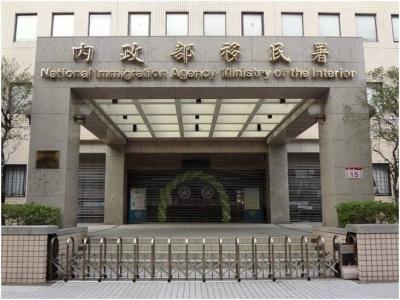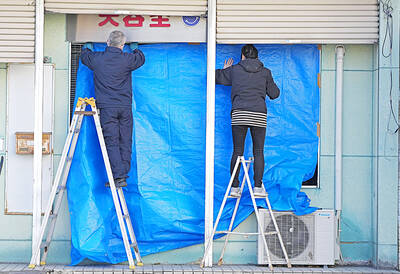It took Faith Hong about a half-hour to run through a century of history and a lifetime of propaganda.
That is her mission as a volunteer at the Taipei 228 Memorial Museum, where she guided her visitors from China through the somber displays, describing the events that set off the killing in 1947 of as many as 28,000 people.
The perpetrators? Troops dispatched to Taiwan by Chinese Nationalist Party (KMT) leader and then-president Chiang Kai-shek (蔣介石). Lest that fact be lost on any visitor, large copies of the written orders he issued are prominently on display.
“They were very evil,” Hong said of the Nationalist troops.
When it comes to facing history, East Asia has issues.
In China, the bloody crackdown on a student-led movement that occupied Tiananmen Square in Beijing in the spring of 1989 is a forbidden topic, the subject of state-sponsored amnesia. Any mention of it on China’s Internet is quickly deleted.
In Japan, seven decades after the end of World War II, its prime minister is under fire from neighboring countries, which say he is playing down Japan’s wartime atrocities, including its use of sex slaves.
Taiwan is different. The most painful event in the island’s modern history is on display in two museums and a park in Taipei devoted to what is called the 228 Incident. They are named, as are so many historical events in the Chinese language, by the month and day it took place.
For four decades, the KMT tried to suppress any discussion of the 228 Incident. The process of restoring those difficult memories has been an integral part of Taiwan’s evolution into a democracy.
Part of that process involved setting up the state-funded museum in 1997 in a building that housed the government’s radio broadcast bureau during the Japanese colonial era. It is in a park near the center of Taipei devoted to remembering the 228 Incident.
As the Taipei 228 museum shows on a street map display, the events actually began on Feb. 27, 1947, when officials enforcing a government tobacco monopoly in Taipei got into a scuffle with a woman selling cigarettes, with one hitting her on the head with the butt of his pistol.
That set off the people of Taiwan, resentful of the KMT’s corrupt and maladroit ways, Hong said, while a soundtrack of street protests played in the background.
Within days, Taiwanese took over much of the administration of the island.
Then-Taiwan governor Chen Yi (陳儀) assembled a force of Nationalist soldiers from China to crush the uprising. The troops killed thousands of people in a spree that began the four decades of “White Terror”— a campaign against the KMT’s opponents, principally the Chinese Communist Party (CCP), that lasted until martial law was lifted in 1987.
At the museum, seemingly nothing is papered over. To somber cello music that evokes Schindler’s List, displays memorialize the lives lost, including much of the island’s elite: painters, lawyers, professors and doctors.
In 1992, an official commission estimated that between 18,000 and 28,000 people had been killed.
“They were patriots; many people who loved the Kuomintang [KMT] were victims,” Hong said. “The young faced the greatest danger.”
Chinese visitors to the museum, who grew up in a country inundated with television shows and textbooks trumpeting the evils of Japan’s wartime occupation of China, got a more nuanced picture from Hong, a retired teacher.
The Japanese were surely exploitative overseers during the decades when they controlled Taiwan, from 1895 to 1945, but they also brought education, sanitation, vaccinations and civilization to Taiwan, Hong said, adding that the cream of Taiwan’s society clamored to enter Japanese universities.
“By 1935, Taiwan was very prosperous, with the second-highest standard of living in Asia,” she said. “The Taiwan people were patriotic, and expected the KMT to preserve that prosperity.”
Hong herself embodies the raucous political freedom that took root in Taiwan starting in the 1990s. Chatting with Chinese visitors, she made no effort to hide her disdain for the KMT.
She also drew the visitors into a conversation about whether China could face the ghosts of its own recent past: the millions of deaths during the famine induced by forced industrialization in the 1950s, the chaos of the Cultural Revolution and the 1989 Tiananmen Square crackdown.
“On the mainland, we just can’t do this,” said one visitor, who wanted to be identified only by her first name in English, Jessica. “But some day we may have this. No matter what, everything progresses.”
Her friend Eric, who is from a city in northern China, said that with more young people studying abroad, China would eventually open up.
For both Eric and Jessica, the museum evoked thoughts of how radically different their government’s approach to the Tiananmen crackdown has been from Taiwan’s to the 228 Incident.
“During that time, the Chinese people could stand up, they could protest, they could express themselves,” Eric said. “But afterward, they couldn’t talk about it, and everyone just focused on chasing money.”
Jim Lee (李筱峰), a professor of Taiwanese culture at National Taipei University of Education, said Taiwan’s experience of first suppressing its history in the interest of social stability, and then forcefully coming to terms with it, could be a “lighthouse for the mainland.”
That is, if the Chinese government and the CCP someday wish to confront the CCP’s own past, especially the suppression of the student-led movements in 1989.
Lai Jeh-hang, (賴澤涵) a history professor at National Central University, said that the process of coming to terms with the 228 Incident led to the flowering of civil society in Taiwan.
“People were no longer afraid to speak out,” he said.
The process continues.
Chen Tsui-lien (陳翠蓮), a historian at National Taiwan University, said the reconciliation was only “halfway through.”
Despite the evidence of the KMT’s responsibility for the killings in 1947, on display at the museum, so far the focus has been on compensating the victims’ families rather than on assigning blame.
“Since there are so many victims, there should be someone responsible, and this part hasn’t been dealt with,” Chen said.

A small number of Taiwanese this year lost their citizenship rights after traveling in China and obtaining a one-time Chinese passport to cross the border into Russia, a source said today. The people signed up through Chinese travel agencies for tours of neighboring Russia with companies claiming they could obtain Russian visas and fast-track border clearance, the source said on condition of anonymity. The travelers were actually issued one-time-use Chinese passports, they said. Taiwanese are prohibited from holding a Chinese passport or household registration. If found to have a Chinese ID, they may lose their resident status under Article 9-1

Taiwanese were praised for their composure after a video filmed by Taiwanese tourists capturing the moment a magnitude 7.5 earthquake struck Japan’s Aomori Prefecture went viral on social media. The video shows a hotel room shaking violently amid Monday’s quake, with objects falling to the ground. Two Taiwanese began filming with their mobile phones, while two others held the sides of a TV to prevent it from falling. When the shaking stopped, the pair calmly took down the TV and laid it flat on a tatami mat, the video shows. The video also captured the group talking about the safety of their companions bathing

PROBLEMATIC APP: Citing more than 1,000 fraud cases, the government is taking the app down for a year, but opposition voices are calling it censorship Chinese Nationalist Party (KMT) Chairwoman Cheng Li-wun (鄭麗文) yesterday decried a government plan to suspend access to Chinese social media platform Xiaohongshu (小紅書) for one year as censorship, while the Presidential Office backed the plan. The Ministry of the Interior on Thursday cited security risks and accusations that the Instagram-like app, known as Rednote in English, had figured in more than 1,700 fraud cases since last year. The company, which has about 3 million users in Taiwan, has not yet responded to requests for comment. “Many people online are already asking ‘How to climb over the firewall to access Xiaohongshu,’” Cheng posted on

A classified Pentagon-produced, multiyear assessment — the Overmatch brief — highlighted unreported Chinese capabilities to destroy US military assets and identified US supply chain choke points, painting a disturbing picture of waning US military might, a New York Times editorial published on Monday said. US Secretary of Defense Pete Hegseth’s comments in November last year that “we lose every time” in Pentagon-conducted war games pitting the US against China further highlighted the uncertainty about the US’ capability to intervene in the event of a Chinese invasion of Taiwan. “It shows the Pentagon’s overreliance on expensive, vulnerable weapons as adversaries field cheap, technologically